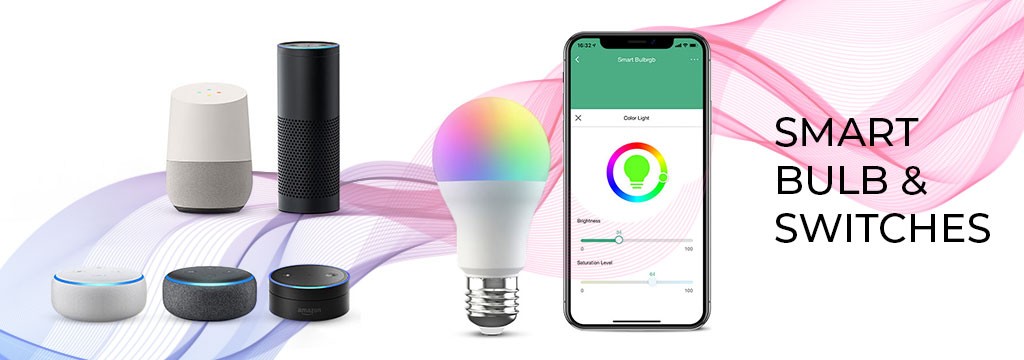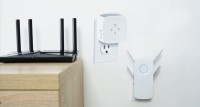A smart light switch is a network-enabled smart home device that allows you to control hardwired lights, ceiling fans, and even fireplaces with an app from your smartphone or with your voice using a virtual assistant. Smart switches add smart home features to anything you turn on or off with the flip of a switch.
What Can a Smart Light Switch Do?
A smart light switch or smart switch lets you control anything in your home connected to a switch with your voice or a smartphone app. Use them to control lights, ceiling fans, bathroom fans, switch-controlled fireplaces, and even the garbage disposal.
Smart Light Switch Features
Let’s look at some of the features you might expect to find in a smart switch:
Wi-Fi connectivity integrates your smart switches into your connected smart home.
Turn switches on and off using the voice control capabilities from Google Assistant or Amazon Alexa. If your smart home is set up with Apple HomeKit, make sure to select smart switches specifically labeled as HomeKit compatible.
If your smart home system uses a hub such as Wink 2 or Samsung SmartThings, double-check for compatibility with Z-Wave or Zigbee, depending on the technology standard used by your smart hub.
Use your smartphone to create custom schedules to turn switches on and off at specific times or turn switches on or off manually with your smartphone while away from home.
Select smart dimmer switches for more precise control of lighting in the kitchen, dining room, bedroom, and living room.
Integrating smart technology into your home can seem like a daunting task, especially if you don’t know where to start. However, smart light bulbs are cost-effective and simple, making them a perfect first step in transitioning your home to a smart home.
How Do Smart Light Bulbs Work?
Smart light bulbs are very similar to regular, incandescent light bulbs, but smart bulbs can partner with a smartphone, tablet, or mobile device. Often, this connection occurs by means of a “hub,” like the Philips Hue bridge, which acts as a gateway between the smart bulbs in your home and your phone or tablet. The hub is attached to a port in your router, but sometimes, smart bulbs don’t have smart hubs at all.
There is wireless technology built into the bulb itself to send messages between your device, the hub (if any), and the bulb, resulting in the bulb turning on or off, changing colors, dimming, or brightening.
Pro Tip: Smart bulbs are best suited for socket-powered table lamps or power sources that lack manual wall switches.
How Do I Set Up a Smart Light Bulb?
Setting up a smart light bulb is simple, because it doesn’t require any heavy-duty installation like drilling or rewiring. Instructions for each bulb may differ, but generally speaking, to set up a smart light bulb:
Plug in the hub. If your smart bulb came with a hub, plug the hub into your router.
Get rid of incandescent bulbs. Remove your old bulb and screw the smart bulb into the desired light fixture.
Visit the app store. Download the mobile application affiliated with the brand of the bulb you purchased.
Connect the bulb to the app. Pair the bulb with the mobile application.
Name your bulbs. Label the bulbs intuitively, like “bedroom night table lamp,” so it’s clear what bulb you’re controlling in the likely event that you pair several.
Where Can I Use Smart Light Bulbs?
You can use smart light bulbs anywhere you would use regular light bulbs, but they are best suited for table lamps and fixtures that are not connected to wall switches. In those situations, a smart light switch could be a better solution, potentially. Additionally, smart bulbs might not be well suited for lights like ceiling fans, because some smart bulbs, especially those without hubs, can be bulky.
What Are Smart Light Bulbs?
Smart light bulbs are lighting devices that you can control wirelessly via a remote. That way, you can control them from different rooms, or even set up different combinations of lights that differ based on the time of day.
Smart light bulbs last longer than regular light bulbs and are more energy-efficient, too.
Benefits of Smart Light Bulbs
Ease of installation isn’t the only thing smart light bulbs have going for them. Other benefits of smart light bulbs include:
Lower energy consumption: Compact fluorescent lamps (CFLs) or light-emitting diode (LED) light bulbs reduce the amount of electricity needed; they use 25 percent to 80 percent less energy than traditional incandescents.3
Long life span: The average incandescent light bulb has a lifespan of 750 to 2,000 hours, while LED smart lights can work for up to 50,000 hours.
Security: Many smart light bulbs have motion-detection features and will turn on if someone enters the room.
Light customization for color and brightness: You can change the bulb color and brightness, designing different “scenes” to fit your various moods.
Scheduling: You can set up a predetermined schedule of when lights turn on and off.
Energy Saver: Scheduling when lights turn on and off can also lower energy consumption, since you’ll never accidentally leave the lights on.
Types of Smart Light Bulbs
There is a range of smart light bulbs with varying bulb shapes and base sizes. Each bulb has a code consisting of a letter and a number like A19,4 so you’ll want to pay attention to what type of bulb is listed as compatible with your fixture, whether that’s a table lamp or ceiling fan.
The most commonly used household bulbs are the A19 and the E26.
 Free Express Shipping
Free Express Shipping















